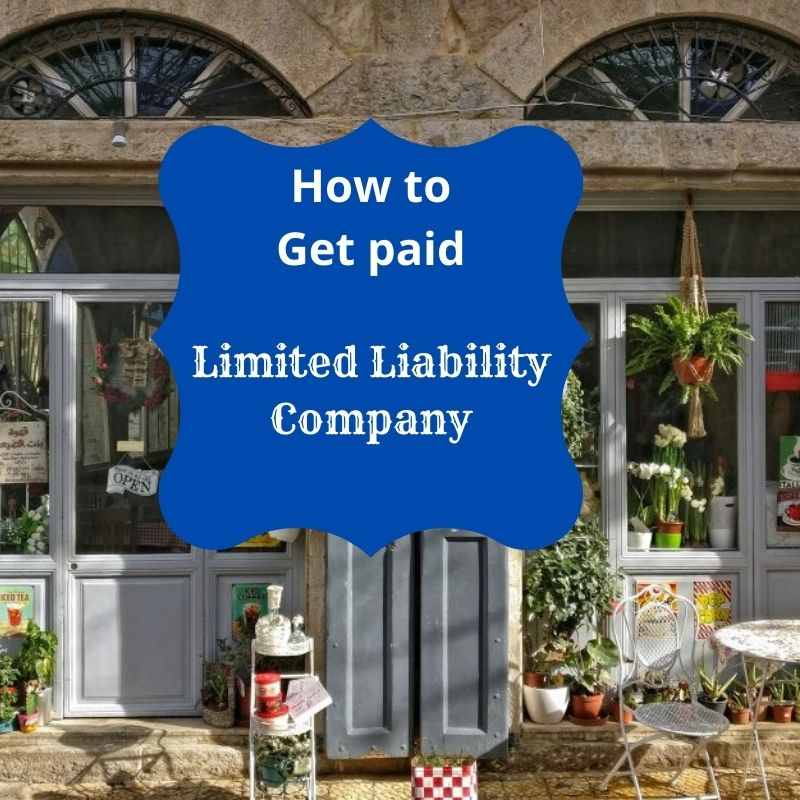As the name implies, a multi-member LLC is composed of more than one owner or member. To get paid as a managing member is different from how you would get paid as a non-managing member.
That said to truly understand how you get paid as the managing member or as a non-managing member you would get paid as a non-manager member of a multi-member LLC there are a few concepts that we need to cover first.
The Truth About Why Draws and Distributions Are Non-Taxable
Most small business founders choose one of the many entity types known as pass-through entities. By definition, a pass-through entity is not subject to income taxes at the entity level. Rather, the owners are taxed individually based on their ownership share of the business.
When you are a pass-through entity, the profits of a business are taxable to the individual owners based on their unique tax situation. Often these owners will take cash out of the business as compensation in the form of periodic draws or distributions.
Assuming you have a profitable business, these draws and distributions are simply a mechanism that allows owners to take out excess cash from the business. Therefore, owner draws and distributions do not have any income tax consequences to the individual.
This concept often creates a level of confusion for founders not versed in a few basic principles of accounting. To understand the concept of an owner-draw or distribution, we must review a few basic accounting principles.
There are 2 primary financial statements for every business. One statement is the Profit & Loss (P&L), sometimes called an income statement. The other statement is a balance sheet. The P&L is a document to record the profit or loss of a business for income taxes while the balance sheet is a document to record the equity in the business.
In accounting, a company has what are known as a chart of accounts. Some chart of account line items are classified as income accounts and some others as expense accounts. Income accounts and expense accounts are reported on the company’s P&L. If you take income and subtract expenses, you are left with net profit, which is also part of the company’s P&L.
P&L (Revenue – Expenses = Net Profit)
Another set of chart of accounts are classified as asset accounts and others as liability accounts. Assets accounts and liability accounts are reported on the company’s balance sheet. If you take your assets and subtract your liabilities, you are left with equity, which is also part of the company’s balance sheet.
Balance Sheet (Assets – Liabilities = Equity)
In accounting, for every transaction, there is a debit and credit taking place between two charts of accounts.

When you write a company-check to pay a bill, such as when you buy some business books, you take money from a chart of account line item called cash (Cash is an asset and lives on your balance sheet) to pay a bill that lives on your P&L. Bills are allocated to their appropriate expense chart of account line item.
Since you reduced cash on your asset chart of account, equity is also reduced to keep things in balance. Equity has to be reduced because it is the result of your assets minus your liabilities. Additionally, since the cash was used to pay an expense your profit is also reduced. Profits must be reduced because it is the result of income minus expenses.

However, when you take an owner draw or a distribution, you reduce cash (an asset chart of account) and you reduce the owner’s capital (a special equity chart of account). Similarly, if you inject cash into a business, you increase cash and increase the owner’s capital.
The results of an owner-draw or distribution (money leaving the business) or a cash infusion (money entering the business) are that both sides of the transaction are restricted to the chart of accounts that live only on the balance sheet.
Since we know that the P&L is used to compute a company’s tax liability and owner draws, and distributions or infusions do not touch the P&L, there are no tax consequences for doing either an owner draw, distribution, or a cash infusion in the normal course of business. An exception is when you close out the business and have a negative equity situation but that is the subject better left to your CPA.
Therefore, as a lifestyle or micro business, you only need to make sure there is enough cash in the business checking account to cover all non-discretionary expenses. All other money is at your discretion to either take out as a periodic owner draw or distribution on profits or to leave in your business as excess cash or use to pay discretionary expenses in the hopes of growing your business.
How to Get Paid as an Owner of a Pass-Through Entity
In my practice as a small business coach and mentor, a question I often get asked is how do I get paid as a business owner? What makes this question so hard to answers is that it all depends on the type of entity you are and how many owners there are.
Some entities have only one owner while others may have several owners, which changes the way income tax is reported to the IRS.
In a pass-through entity, sometimes income is considered earned income (sometimes called ordinary income or active income) while other times it is considered passive income, which changes the way income taxes are computed.
Your role in the business as a decision-maker (manager) or a simple investor (member) will define how your income taxes are calculated.
Income tax treatment, therefore, will dictate the way you will get paid as an owner.
What Is a Pass-Through Entity?
Most small business founders choose one of the many entity types known as pass-through entities. By definition, a pass-through entity is not subject to income taxes at the entity level. Rather, the owners are taxed individually based on their ownership share of the business in a tax-advantaged way. The only entity not considered a pass-through is the C-Corp.
How to Report the Profit and Loss of Business
A company should have a Profit & Loss (P&L), or income statement, which is an internally prepared tax document that is used by the business to compute the business owner(s) annual tax liability.
When the business is a Multi-Member LLC, the P&L is used to produce Form 1065. The 1065 is an informational tax return that is sent to the IRS. The business will also produce K1’s that are sent to each owner.
What Is Passive Income vs. Earned Income?
When the income derived by the business comes as the result of some form of labor, then the income is classified as earned income. Earned income is subject to FICA (Social Security) and Medicare taxes.
However, sometimes income from the business does not involve labor, such as when a business’s income comes from charging rent to a tenant. When the income is not the result of labor, the income is considered passive income, and as a result, it is not subject to FICA or Medicare taxes and is reported on Schedule E of the individual’s 1040 tax return.
Even within a single entity, the income for one owner may be considered earned income while another owner’s income might be considered passive income. The distinction comes if the individual owner either works more than 500 hours in the business or is in a management position and makes day-to-day decisions for the business.
When an owner’s income is considered earned income, that owner has some options for tax deductions such as healthcare or retirement contributions that owners who receive passive income do not. Of course, the owners with earned income then subject that income to FICA and Medicare taxes.
What Are Self-Employment (SE) Taxes?
As an employee, we are used to having 7.65% deducted from our net income as our part of our FICA and Medicare tax contributions. What you don’t see as an employee is that the employer is obligated to match your FICA and Medicare tax contributions.
When your income from the business is considered earned income (therefore subject to FICA and Medicare taxes) and you are also an owner of the business, then you are both the employee and employer in the eyes of the IRS. As a result, you must pay both the employee and the employer portions of FICA and Medicare taxes. When we talk about self-employment or SE taxes, we are including both the employee (7.65%) and employer (7.65%) portions of the FICA/Medicare contribution for a total of 15.3%.
How to Get Paid in a Multi-Member LLC
A multi-member LLC is composed of more than one owner or member so the business will submit an informational return to the IRS known as a Form 1065. Each of the owners will be issued a K1 that will indicate the portion of the profit and loss that the individual will be responsible for claiming on their Schedule E (supplemental income and loss) and their personal 1040 tax return.
The K1 for each owner will designate how the owner’s share of income, deductions, and credits are allocated for tax purposes.
Remember from the section on How to Get Paid as an Owner of a Pass-Through Entity we indicated that managers are treated differently than members who are non-managers.
To be clear, while the members of an LLC are responsible for paying the taxes for a profitable business based on their individual marginal tax rates, the business does not have to physically write the members checks for the total amount of the business’s profits. In fact, it is not wise to distribute 100% of the profit to the members. The business should leave some of the equity in the business as there needs to be sufficient cash to cover any net loss the business may incur in the future and to provide the needed capital for future growth.
For my owners, I would generally issue distributions to cover the owner’s taxes and we would retain the rest of the profits in the business to reinvest in the business’s growth.
How to Get Paid as a Manager Member of a Multi-Member LLC
When you are a manager of a multi-member LLC you by default are an employee of the company, and therefore, your income is considered earned income. Moreover, since you are also a member of the LLC, all your income will be subject to self-employment tax (15.3%) in addition to your marginal tax rate for federal and state income taxes. Remember that your marginal tax rate is the result of your collective income from all sources and that each member can potentially have a different marginal tax rate. Finally, since you are a manager, your liability protection is not as limited as limited members because you are a decision-maker.
While being a manager member causes all your income to be considered earned income, making it subjected to self-employment tax and your liability not being as limited non-manager members, the good news is you are eligible for some deductions such as for healthcare and/or retirement plan contributions.
As a member, you will use the K1 issued by the business to populate your Schedule E. Since you are also a manager and subject to earned income, you will also need to complete a Schedule SE (self-employment tax) to report your income that is subject to self-employment taxes.
Throughout the year, the business may make guaranteed payments as a way of compensating you as the manager whether the business makes a profit or not. Guaranteed payments differ from a salary or wages in that the business does not withhold taxes on guaranteed payments. However, the guaranteed payments are an expense to the business that will lower its taxable income. The guaranteed payments made to you as the manager are subject to self-employment taxes when you file your personal taxes.
The business may also make periodic distributions (member draws) to compensate you as a member. The business maintains a capital account for each member. As a distribution (member draw) is made, the member’s equity is reduced. Like a guaranteed payment, the business does not withhold taxes on distributions (member draws). Since distributions (member draws) are not an expense to the business, they are not a deduction to the business.
All compensation made to you as the manager member including guaranteed payments and your profit share are all subject to SE taxes when you file your personal taxes. Your profit share and guaranteed payments will be included on your K1.
When it comes to guaranteed payments and your profit share, the onus is on you to estimate the taxable income you will receive and then make quarterly deposits to the IRS using Form 1040-ES to cover the anticipated annual tax liabilities. The same is true for your estimated state taxes. To avoid IRS penalties, your tax estimates should add up to at least 90% of your estimated tax liability.
How to Get Paid as a Non-Manager Member of a Multi-Member LLC
When you are an investor in a multi-member LLC, work less than 500 hours in a given tax year for the LLC, and you do not participate in its management, you are considered limited in your liability and your income is usually considered passive income with respect to how you get paid for your return on investment. Passive income, as you will recall, is not subject to FICA or Medicare. Therefore, your income will be subject to federal and state income taxes based on your marginal tax rate only.
As a non-manager member, you will use the K1 issued by the business to populate your Schedule E. Since your income is considered passive income, you are not subject to self-employment taxes.
Throughout the year, the business can make periodic distributions (member draws) to compensate you as a member. The business maintains a capital account for each member. As a distribution (member draw) is made, the member’s equity is reduced. The business does not withhold taxes on distributions. Since distributions are not an expense to the business, distributions are not a deduction to the business.
The operating agreement may also provide guaranteed payments to members whether the business makes a profit or not. Guaranteed payments differ from a salary or wages in that the business does not withhold taxes on guaranteed payments. However, the guaranteed payments are an expense to the business that will lower its taxable income. These guaranteed payments are considered earned income to the member and are subject to self-employment taxes so that the member can deduct self-employed health insurance and retirement contributions.
In addition to any guarantee payment made to the member, the member’s profit share and their member draws will also appear on the K1. However, since the member’s profit share is considered passive income, it is not subject to self-employment taxes.
When it comes to guaranteed payments and your profit share, the onus is on you to estimate the taxable income you will receive and then make quarterly deposits to the IRS using Form 1040-ES to cover the anticipated annual tax liabilities. The same is true for your estimated state taxes. To avoid IRS penalties, your tax estimates should add up to at least 90% of your estimated tax liability.
How to Get Paid as a Non-Member General Manager of a Multi-Member LLC
In some cases, all the members of a multi-member LLC may be investors only and not managers. The business may hire an outside non-member general manager (employee) to make the day-to-day decisions, and therefore, acts as the manager. In this case, the manager is an employee of the business, but since they are not a member (aka owner), their income is just like that of an employee in any business.
The salary or wages of a non-member general manager is subject to the employee portion of FICA and Medicare tax only and the business (LLC) is responsible for the payroll taxes (matching FICA and Medicare tax and unemployment taxes). Of course, the non-member general manager is also subject to federal and state income taxes based on their marginal tax rate as well.
As a non-member general manager, they will receive a salary or wage to compensate them as the manager. The business will withhold from their compensation the estimated taxes and make periodic deposits on behalf of the employee to the IRS, state, FICA, and Medicare. The earnings the non-member general manager receives will be reported on a W2 form at the end of the tax year.
The wage or salary paid to the non-member general manager as well the associated payroll taxes are expenses to the business that will lower its taxable income.
How you get paid depends upon if your a managing member, a non-managing member or a non-member general managerof a limited liability company. Are you paying people properly?
I would like to acknowledge Karen Absher of KSA Financial & Tax Services for her gracious assistance as a reviewer to make sure that the tax issues conveyed in this post were an accurate representation of US tax law.









